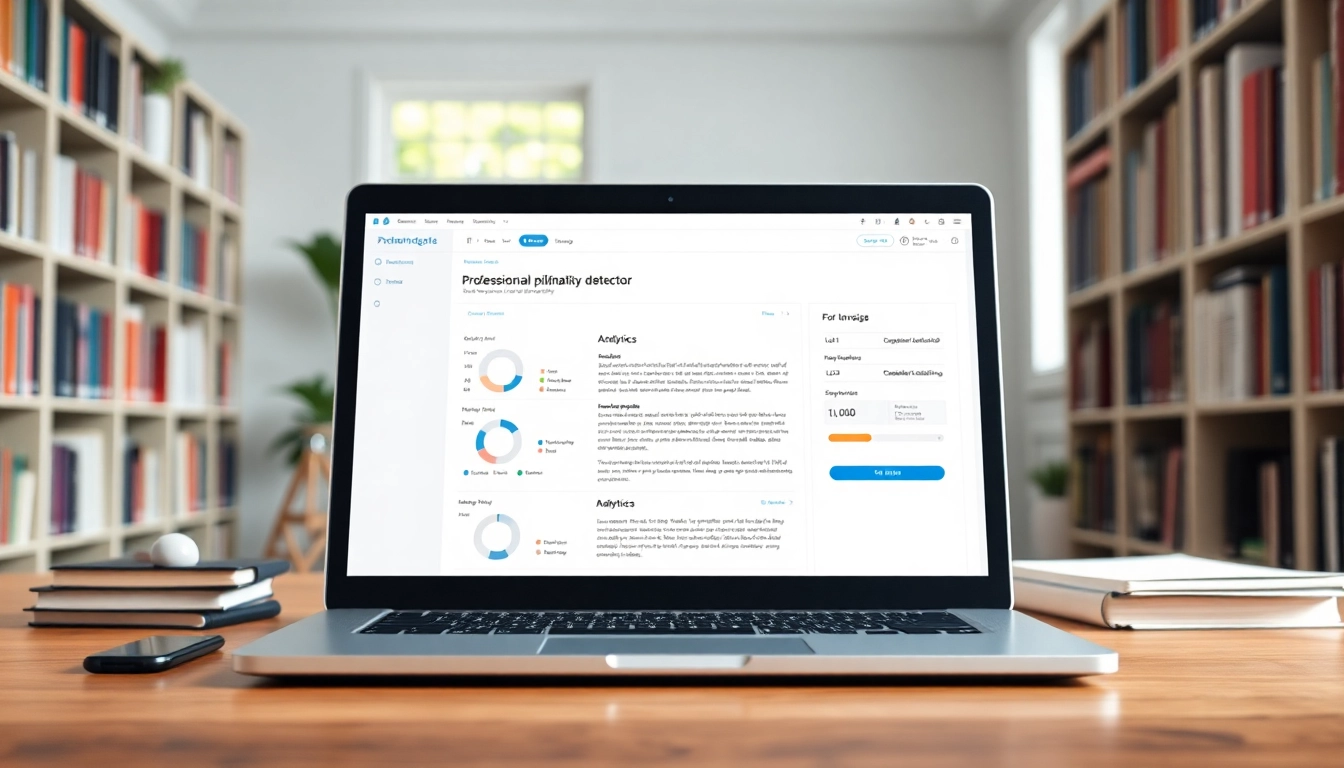Understanding Plagiarism and Its Consequences
Plagiarism is a significant concern in academic and professional environments, affecting the credibility of writers, students, and researchers alike. This article serves as an authoritative guide on plagiarism detection, discussing its ramifications and providing insights into enhancing academic integrity. Whether you’re a student crafting an essay or a scholar publishing research, understanding the nuances of plagiarism, including how to effectively utilize a plagiarism detector, is crucial.
What is Plagiarism?
Plagiarism is the act of using someone else’s work, ideas, or intellectual property without proper acknowledgment, presenting them as your own. This unethical practice can occur in various forms, ranging from outright copying text to paraphrasing someone else’s ideas without credit. Understanding plagiarism is essential to maintaining academic honesty and integrity.
Types of Plagiarism
Plagiarism can manifest in several ways, each with its own implications:
- Direct Plagiarism: The verbatim copying of someone else’s work without attribution.
- Self-Plagiarism: Reusing one’s previous work without acknowledgment, often seen in academic publications.
- Paraphrasing Plagiarism: Rewording someone else’s ideas without proper citation, even if the text is not copied directly.
- Accidental Plagiarism: Unintentionally failing to cite sources correctly, usually due to lack of knowledge or oversight.
- Assembly Plagiarism: Combining various sources without proper citation, presenting it as a cohesive piece of original work.
Consequences of Plagiarism in Academia
The repercussions of plagiarism can be severe, impacting both academic and professional futures:
- Academic Consequences: Students can face disciplinary actions, including failing grades, suspension, or expulsion.
- Professional Consequences: Plagiarism can lead to job termination, loss of professional reputation, and legal implications.
- Loss of Credibility: Both individuals and institutions can suffer a loss of trust and respect, which can take years to rebuild.
How a Plagiarism Detector Works
Effective plagiarism detectors employ a combination of advanced technologies to identify instances of unoriginal content. Understanding how these tools function can enhance your ability to utilize them effectively.
Technology Behind Plagiarism Detection
Most plagiarism detection tools utilize several technologies, including:
- Text Matching: Scanning text for exact matches within a large database, which includes both web content and academic publications.
- Algorithmic Analysis: Applying algorithms that assess sentence structure and phrasing to detect paraphrasing.
- Machine Learning: Constantly improving their detection capabilities by learning from feedback and new data.
Key Features of Effective Detectors
When selecting a plagiarism detector, consider these crucial features:
- Comprehensive Database: A tool should access a wide range of online content, academic journals, and proprietary databases.
- Report Generation: Detailed reports outlining the detected plagiarism, including percentage scores and source links, help users understand their results.
- User-Friendly Interface: A straightforward, easy-to-navigate interface can significantly improve the user experience.
Integration with Writing Tools
Modern plagiarism detectors often integrate with writing tools and platforms, enhancing usability:
- Word Processors: Integration with tools like Microsoft Word and Google Docs allows users to check for plagiarism directly while writing.
- Browser Extensions: Some detectors offer browser extensions to check content sourced from the web in real-time.
- API Access: Developers can incorporate plagiarism detection features into their applications via API access.
Choosing the Right Plagiarism Detector
With numerous plagiarism detection tools available, choosing the right one can be challenging. However, certain criteria can help you make an informed decision.
Features to Look For
Prioritize the following features when evaluating plagiarism detectors:
- Real-Time Checking: The ability to check documents as they are written or edited saves time and improves accuracy.
- Support for Multiple File Formats: Detecting plagiarism in various formats (e.g., PDF, DOC, TXT) is essential, especially for academic institutions.
- Customizable Settings: Options to adjust sensitivity and specific checks according to your needs are beneficial.
Pricing and Subscription Models
Plagiarism detectors vary widely in cost, ranging from free versions to premium subscriptions. Here’s how to navigate pricing:
- Free Options: Some basic tools offer free checking but may lack comprehensive databases or algorithms.
- Pay-Per-Check Models: Useful for occasional users, allowing for single submissions rather than a subscription.
- Subscription Plans: Often provide unlimited checks, additional features, and priority support, making them ideal for students and professionals.
User Reviews and Recommendations
User feedback can provide insight into the effectiveness and reliability of a plagiarism detector. Research reviews to find:
- Success Rates: Consistent reports of success in identifying various types of plagiarism can indicate quality.
- Customer Support: Testimonials about responsiveness and helpfulness can highlight a tool’s reliability.
- User Experience: Positive experiences regarding ease of use and comprehension of reports are also essential factors.
Best Practices for Using a Plagiarism Detector
While having access to a plagiarism detector is beneficial, understanding how to use it effectively is equally important.
Preparing Your Document for Analysis
Before submitting your work for plagiarism checking, consider these preparation steps:
- Format Cleanliness: Ensure your document is free of hidden characters and unnecessary formatting that might interfere with the scanning process.
- Complete Draft: Check a full and finished document for more accurate analysis, as partial checks can lead to misleading results.
- Clear Citations: Properly cite all sources to reduce the risk of unintentional plagiarism before conducting a check.
Interpreting the Results
Once you receive your plagiarism report, understanding the results is crucial:
- Percentage of Plagiarism: A higher percentage indicates a greater level of overlap with existing sources.
- Source Links: Review the listed sources to understand where potential plagiarism occurred; this allows for better revision and crediting.
- Feedback Provided: Some detectors also provide actionable feedback, highlighting specific areas that need correction.
Improving Your Writing Based on Feedback
Feedback from a plagiarism detector can help enhance your writing skills:
- Revision Recommendations: Use the insights gained from the report to revise and improve your work, learning how to better paraphrase and cite sources.
- Understanding Originality: Familiarize yourself with patterns of writing and citation practices through repeated use of the detector.
- Ongoing Education: Engage in workshops or tutorials concerning proper citation methods and avoiding plagiarism in the future.
Future Trends in Plagiarism Detection
As technology evolves, plagiarism detection is set to undergo significant changes, influenced by trends in AI and educational standards.
AI and Machine Learning Innovations
AI and machine learning are transforming plagiarism detection through improved algorithms and more comprehensive databases:
- Advanced Pattern Recognition: Future tools will leverage AI to better understand writing styles and detect subtle forms of plagiarism.
- Real-Time Detection: Enhanced integration with writing software will allow for immediate feedback during the writing process, reducing instances of unintentional plagiarism.
Focus on Academic Integrity
The growing focus on academic integrity will lead to stricter policies and enhanced educational resources:
- Institutional Policies: Colleges and universities may establish more rigorous anti-plagiarism guidelines, requiring the use of specific tools.
- Training Programs: Educational institutions will likely introduce programs aimed at promoting best practices in citation and originality.
Adapting to Changing Education Standards
As educational standards continue to evolve, plagiarism detection must also adapt. Trends to watch include:
- Emphasis on Creative Expression: With the rise of digital content creation, new forms of plagiarism detection will need to evaluate originality and creativity.
- Globalization of Education: As education becomes more international, plagiarism detectors will have to accommodate diverse citation styles and languages.



